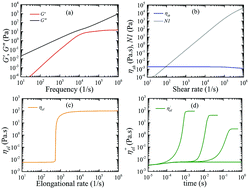当前位置:
X-MOL 学术
›
Soft Matter
›
论文详情
Our official English website, www.x-mol.net, welcomes your feedback! (Note: you will need to create a separate account there.)
How viscoelastic is human blood plasma?
Soft Matter ( IF 3.4 ) Pub Date : 2018-03-13 00:00:00 , DOI: 10.1039/c8sm00061a S. Varchanis 1, 2, 3, 4, 5 , Y. Dimakopoulos 1, 2, 3, 4, 5 , C. Wagner 6, 7, 8, 9 , J. Tsamopoulos 1, 2, 3, 4, 5
Soft Matter ( IF 3.4 ) Pub Date : 2018-03-13 00:00:00 , DOI: 10.1039/c8sm00061a S. Varchanis 1, 2, 3, 4, 5 , Y. Dimakopoulos 1, 2, 3, 4, 5 , C. Wagner 6, 7, 8, 9 , J. Tsamopoulos 1, 2, 3, 4, 5
Affiliation

|
Blood plasma has been considered a Newtonian fluid for decades. Recent experiments (Brust et al., Phys. Rev. Lett., 2013, 110) revealed that blood plasma has a pronounced viscoelastic behavior. This claim was based on purely elastic effects observed in the collapse of a thin plasma filament and the fast flow of plasma inside a contraction–expansion microchannel. However, due to the fact that plasma is a solution with very low viscosity, conventional rotational rheometers are not able to stretch the proteins effectively and thus, provide information about the viscoelastic properties of plasma. Using computational rheology and a molecular-based constitutive model, we predict accurately the rheological response of human blood plasma in strong extensional and constriction complex flows. The complete rheological characterization of plasma yields the first quantitative estimation of its viscoelastic properties in shear and extensional flows. We find that although plasma is characterized by a spectrum of ultra-short relaxation times (on the order of 10−3–10−5 s), its elastic nature dominates in flows that feature high shear and extensional rates, such as blood flow in microvessels. We show that plasma exhibits intense strain hardening when exposed to extensional deformations due to the stretch of the proteins in its bulk. In addition, using simple theoretical considerations we propose fibrinogen as the main candidate that attributes elasticity to plasma. These findings confirm that human blood plasma features bulk viscoelasticity and indicate that this non-Newtonian response should be seriously taken into consideration when examining whole blood flow.
中文翻译:

人体血浆的粘弹性如何?
数十年来,血浆一直被认为是牛顿流体。最近的实验(布鲁斯特等人,物理评论快报。,2013年,110)表明血浆具有明显的粘弹性行为。这种说法是基于在细的等离子细丝的塌缩和收缩-扩张微通道内部的等离子体的快速流动中观察到的纯弹性效应。然而,由于血浆是具有非常低粘度的溶液的事实,常规的旋转流变仪不能有效地拉伸蛋白质,因此不能提供有关血浆的粘弹性的信息。使用计算流变学和基于分子的本构模型,我们可以准确预测人血浆在强扩展和收缩复杂流动中的流变响应。血浆的完整流变学特征可对其在剪切流和拉伸流中的粘弹性进行首次定量估计。−3 –10 -5 s),其弹性特性在具有高剪切和扩展速率的流中占主导地位,例如微血管中的血流。我们显示血浆暴露于延伸变形时由于血浆中大量蛋白质的拉伸而表现出强烈的应变硬化。此外,基于简单的理论考虑,我们建议将纤维蛋白原作为将弹性归因于血浆的主要候选药物。这些发现证实人血浆具有大量粘弹性,并表明在检查全血流量时应认真考虑这种非牛顿反应。
更新日期:2018-03-13
中文翻译:

人体血浆的粘弹性如何?
数十年来,血浆一直被认为是牛顿流体。最近的实验(布鲁斯特等人,物理评论快报。,2013年,110)表明血浆具有明显的粘弹性行为。这种说法是基于在细的等离子细丝的塌缩和收缩-扩张微通道内部的等离子体的快速流动中观察到的纯弹性效应。然而,由于血浆是具有非常低粘度的溶液的事实,常规的旋转流变仪不能有效地拉伸蛋白质,因此不能提供有关血浆的粘弹性的信息。使用计算流变学和基于分子的本构模型,我们可以准确预测人血浆在强扩展和收缩复杂流动中的流变响应。血浆的完整流变学特征可对其在剪切流和拉伸流中的粘弹性进行首次定量估计。−3 –10 -5 s),其弹性特性在具有高剪切和扩展速率的流中占主导地位,例如微血管中的血流。我们显示血浆暴露于延伸变形时由于血浆中大量蛋白质的拉伸而表现出强烈的应变硬化。此外,基于简单的理论考虑,我们建议将纤维蛋白原作为将弹性归因于血浆的主要候选药物。这些发现证实人血浆具有大量粘弹性,并表明在检查全血流量时应认真考虑这种非牛顿反应。



























 京公网安备 11010802027423号
京公网安备 11010802027423号